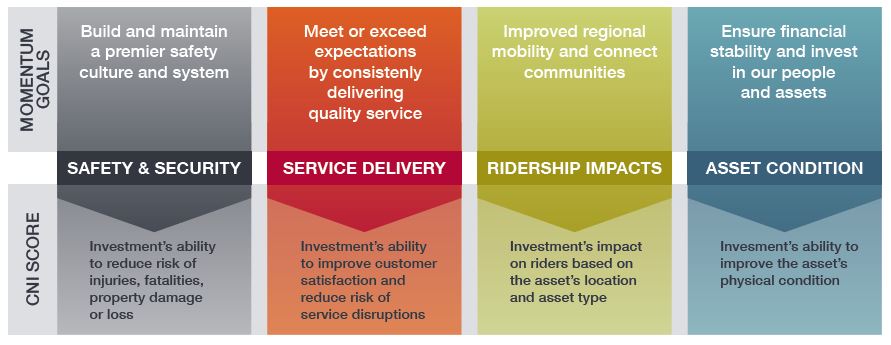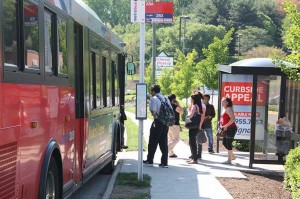Metro used a risk-based multi-factor methodology to score and rank its 10 year capital needs.
Metro’s 2016 Capital Needs Inventory (CNI) aims to capture and quantify Metro’s existing and anticipated capital needs over the next ten years. With our needs far outpacing available funding, prioritization of capital needs is critical. But with the ever present constraints of budget, time, and staffing, how do we determine how to prioritize our new and existing needs across a 10 year period? Metro used a risk based approach to develop its 10 year capital needs prioritization. Each criterion is defined based on the impact of an investment to improve an asset’s condition, to thereby improve Metro’s state of good repair or to mitigate asset related risks.

The risk-based prioritization approach is illustrated above. This approach considers both the likelihood of asset failure and consequence of asset failure. The scoring uses weighted criteria, to represent either the likelihood or consequence of asset failure. For instance, the scoring helps us to decide if it is more urgent to replace one kind of asset over another in any given year, given agency priorities and finite resources. A safety focused weighting scenario, based on the extent that an asset’s failure would affect overall system and rider safety was developed to reflect Metro’s core mission and values. It was also important that Metro’s weighting criteria be aligned with its larger strategic goals. The image below demonstrates how Metro’s strategic goals were aligned with CNI scoring weights.

Once Metro’s 10 year capital needs were identified and compiled, they went through several rounds of prioritization testing based on the risk-based approach and generated prioritization scores for individual assets in the asset inventory.

After the completion of CNI, the identified capital needs must be further verified and then converted into build-able projects through a design and engineering process, which will define actual capital projects with scopes, schedules, cost estimates, and delivery methods.
Metro kicks off an evaluation of bus-only lane enforcement strategies.

Montgomery County uses bus cameras to enforce safe driving rules around school buses.
As the state and local departments of transportation begin to consider bus priority treatments (PDF) in earnest, their success will be dependent on the development and implementation of a comprehensive driver education and lane enforcement strategy prior to the bus lane installation.
New bus-only lanes are currently being implemented or are planned in many of our compact jurisdictions: Corridors currently under study include Georgia Avenue NW in DC, Rockville Pike in Montgomery County and Leesburg Pike in Northern Virginia. As BRT becomes a more popular and effective mode for cities seeking high-quality, higher-speed transit at a relatively low cost, there is an increasing interest in identifying strategies to successfully enforce vehicle restrictions in bus-only lanes. Read more…
The Northern Virginia Transportation Commission is looking for ideas for Route 7.
 The Leesburg Pike (Route 7) corridor in Northern Virginia is second only to Columbia Pike in its daily volumes of bus riders. This busy, mixed use corridor connects Alexandria, Arlington, Fairfax County, and the City of Falls Church. The corridor connects many vital regional activity centers including Old Town Alexandria, Seven Corners, downtown Falls Church (Broad Street) and Tysons Corner.
The Leesburg Pike (Route 7) corridor in Northern Virginia is second only to Columbia Pike in its daily volumes of bus riders. This busy, mixed use corridor connects Alexandria, Arlington, Fairfax County, and the City of Falls Church. The corridor connects many vital regional activity centers including Old Town Alexandria, Seven Corners, downtown Falls Church (Broad Street) and Tysons Corner.
In 2009, in recognition of the importance of this corridor, Metro completed an evaluation of the 28A and 28B lines, and concluded that there was a demand for a robust, limited stop service on Leesburg Pike. The study acknowledged that by 2040, population in the corridor is anticipated to increase by 36% and the number of jobs is anticipated to increase by 34% . These changes will mean that without more high quality transit, vehicle congestion will only increase. The study also identified heavy congestion as a major impediment to consistent, on-time performance and recommended traffic signal improvements and queue jumps at targeted intersections. As a result of the study, frequencies were increased on 28A and a limited stop service (28X) was introduced to serve the heaviest traveled portions of the route. Read more…
Since the signing of the WMATA compact more than 40 years ago, there has been an ongoing debate about the role of Metrobus as the Washington region’s primary bus service provider.
Prior to the formation of Metrobus in 1973, bus services in the Washington region were operated by numerous private providers across the region operating on dedicated lanes, many of which were operating at a loss. In the 1970s, Metro consolidated bus service under the Metrobus brand and increased service and headways throughout the WMATA compact area. While Metro’s role as the regional rail provider has always been clear, its role as a bus provider has been more nuanced.

Old DC Transit and Metrobuses from the 1960s and 70s
This is the first in a series of posts which aim to provide a brief overview of the efforts undertaken over the past 20 years by Metro, and its regional partners, to balance the responsibilities and funding of Metrobus with the wants and needs of our jurisdictional partners all while maintaining our regionally focused mission.
Read more…
New Metro study evaluates best practices for the coordination of bus service with new, street-running rail services.

What’s old is new again! Capital Transit vehicles sharing the road in 1947.
In the Washington region, bus rapid transit (BRT), light rail transit (LRT) and streetcar (SC) systems are currently under study or construction on major transit corridors in every jurisdiction. Each is being planned by a different agency with different sets of goals and aspirations. Most of these corridors currently are already served by Metrobus and have heavy bus ridership. All of these projects can leave a bus planner wondering how all of these modes will work together and with the existing Metrobus system.
Some existing riders will be fully served by the new service; however, many others will require a combination of existing bus service and the new fixed route transit to reach their final destinations. As transit professionals, the ability for our customers to navigate seamlessly though the region via transit, regardless of the mode or operator, is our ultimate goal. Towards that end, we have been working on a set of guidelines for the operations planning of buses and new modes traveling in the same corridors. Read more…

As bus service providers, we must wrestle with often-conflicting goals: providing fast, yet accessible, bus service. Our customers expect that once they are on the bus, the service will be fast and reliable, but that when they want to board the bus, a stop will be as close to their origin or destination as possible.
Metro often receives complaints that our buses stop every block, making travel times slow. And with stops on virtually every block, it is difficult for our schedulers to accurately determine how often the bus will stop, making the establishment of time points for accurate scheduling more art than science.
However, most times when we propose to remove an underused or poorly placed stop, the few people using the stop will mobilize, often lobbying their elected officials to have it reinstalled. Everyone wants faster service; they just don’t want it at the expense of their stop.
Read more…










Recent Comments